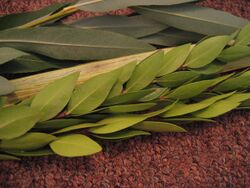Biology:Hadass
This article relies largely or entirely on a single source. (January 2020) |
Hadass (Hebrew: הדס, pl. hadassim - הדסים) is a branch of the myrtle tree that forms part of the lulav used on the Jewish holiday of Sukkot.
Hadass is one of the Four species (arba'ah minim–ארבעת המינים). The others are the lulav (palm frond), aravah (willow), and etrog (citron). Three hadassim are incorporated into the Four Species and are bound together with the lulav and aravah. Together with the etrog, the lulav is waved in all four directions, plus up and down, to attest to God's mastery over all creation, and to voice a prayer for adequate rainfall over all the Earth's vegetation in the coming year.
The hadass grows in tiers of three leaves. According to the Halakha, the most perfect hadass is one whose leaves grow evenly in each set of three.[1]
Hadass is also used as the "Besamim" or holy spices in some Sephardic and Mizrahi customs for Havdalah.
References
- Kitov, Eliyahu (1978). The Book of Our Heritage. Jerusalem: Feldheim Publishers. ISBN:0-87306-152-7.
External links
he:הדס#ההדס בארבעת המינים
 |


